#E65OZ18
Explore tagged Tumblr posts
Photo



Kangaroo Carnage
After you get over the initial delight in seeing so many kangaroos in the wild, bouncing in the sand and peeking at you over the bushes, you soon begin to realize something is wrong.
New South Wales has been suffering drought conditions for over six months. We have seen Road Train loads of hay being trucked in to help save the cattle and we met a farmer in the back country that told us that their sheep stocks were a third of normal as the rest had been sold rather than have them starve.
None of this works for wildlife.
Kangaroos are herbivores eating grasses, flowers, ferns and leaves and the countryside in the outback currently has nome of these in any abundance. The recent rains have made some grass grow but a lot of this is where the water runs off the roads.
Kangaroos eating closer and closer to roads has predictable consequences. On the 200km stretch from Wilcannia to Broken Hill on the highway, we probably saw at least a thousand dead kangaroos. Hard to say how long each had been there but that’s a staggering number of dead animals.
In the other photos, the red kangaroo was just outside White Cliffs but too weak to run away. The grey guy was a few feet from out motel essentially scavenging for scraps.
Heartbreaking.
2 notes
·
View notes
Photo
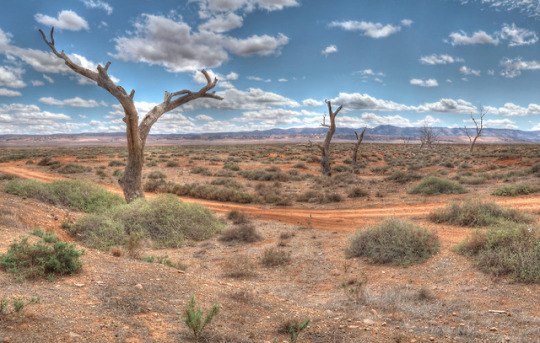
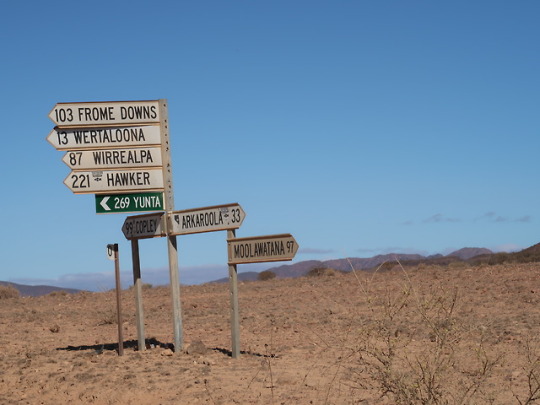
You Know You are in the Middle of Nowhere ...
... when You are 267 Kilometers to Nowhere.
Reginald Sprigg was an Australian geologist who made two huge impacts in his life.
First he discovered fossils in 1946 that established proof of the first animals that helped date and explain the Cambrian Explosion - the amazing proliferation of ever more complex creatures after billions of years of almost no change in the Earth’s evolved organisms. Spoiler alert - we all come from jellyfish - sorry to break it to you. He was out surveying old mines for potential new uses and, reportedly, came across these fossils whilst having lunch. You stub your toe in the vastness of the Australian outback and, change science forever. You have to know what you are looking for I suppose.
This was in the Ediacara Hills - seen in this photo taken in the Flinders Ranges near Parachilna in South Australia. They even added the Edicaran Period in the geological table to recognize this change in the way we have to think about evolution.
Then in 1968 he bought a few hundred acres in the Northern Flinders that was once a uranium exploration site that he had extensively surveyed (yes there is uranium under here) and turned it into the Arkaroola Wilderness Sanctuary. You know this is in the middle of nowhere when it’s hundreds of kilometers to nowhere.
Tomorrow, sadly, we are leaving Arkaroola after a stay they was extended to fix my second serious puncture. The area is spectacular, the hotel and food are perfect, and the people here are a delight.
Within an hour of getting back from a day ride with a serious tyre problem, the staff had figured out someone was coming up from Port Augusta (350 Km away) and could bring a tyre that someone else could collect from Copley (150 Km away) and get here by the afternoon. No fuss and a literal and figurative bush telegraph was setup to get us out of a bind.
“No worries mate. Too easy” as they say in Australia.
1 note
·
View note
Photo


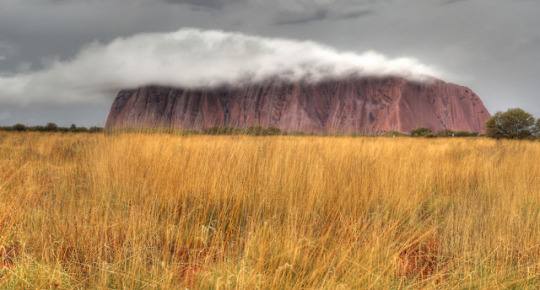
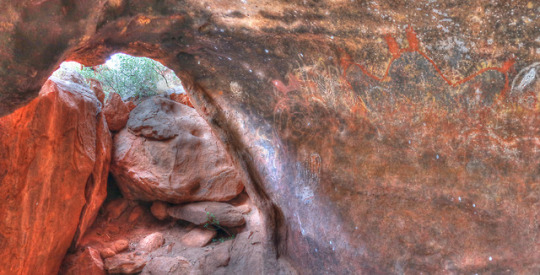
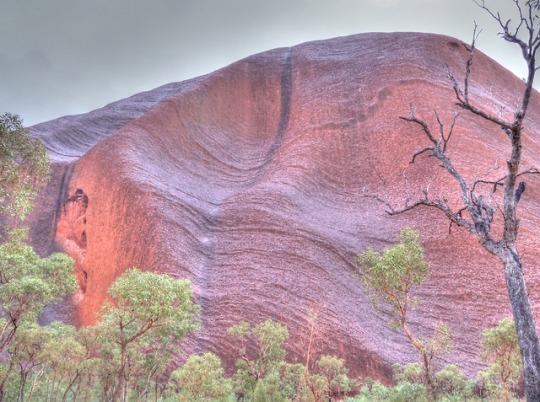
If You Don’t Preserve It - You Don’t Deserve It.
The creation myth of the aboriginal people is a charming and seductive story.
In the Dreamtime, everything was already there under the surface of the earth and came into being because the ancestors broke through and made things real by describing and singing about them. Everything - rocks, plants, rivers, insects - came into being through song and will return from view if we do not continue to revere and sing about them. If we don’t preserve it, we don’t deserve it.
This is complete nonsense, or course, but so is the basis for every religion. The idea of God creating heaven and earth and resting on the sabbath, or that God spoke through a shepherd in Mecca or Joseph Smith in New York, or that Gaea and Chaos procreated to create darkness and light. And don’t get me started on Brahma and Vishnu and Shiva. Too many gods; they cannot all be right.
When the Christian British arrived here they obviously thought that the “natives” were worthless lazy hunter-gatherers with no culture and no religion and no law. But the real Australians had been managing this land and practicing according to a consistent law for 60,000 years before white people were even white. Myth and law and tradition here have been combined for millennia.
Aboriginal clans have obviously fought over things but they also exchange important tokens to cement a common understanding of how interdependent we all are. There were territories but no fences. There is the idea of “tenderrum” which welcomes others when needed on the assumption that they would leave afterwards. Land wasn’t something controlled and traded with deeds but a common resource that everyone has a responsibility to maintain and share. Just because aboriginals were wanderers does not mean they had no idea of responsibility; all the country was linked by songlines and “ways through” that had to be maintained and respected.
There’s a lot to learn from this as we look at climate change, and population growth, and water shortage and all their consequences.
Oh, and every other religion has produced terrorists in its name - but not here.
The photos are of Uluru in a rainstorm including the astonishing sight of a standing lenticular wave over the rock. Also the petroglyphs near the head of the Kuniya trail when you can see the image of the sand python who created Uluru high on the wall of this canyon.
0 notes
Photo
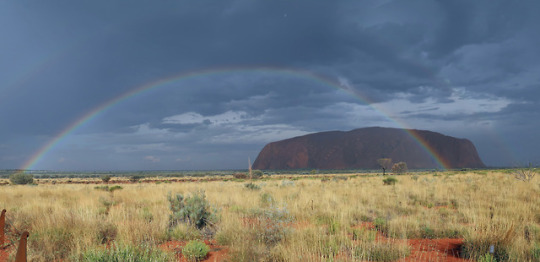

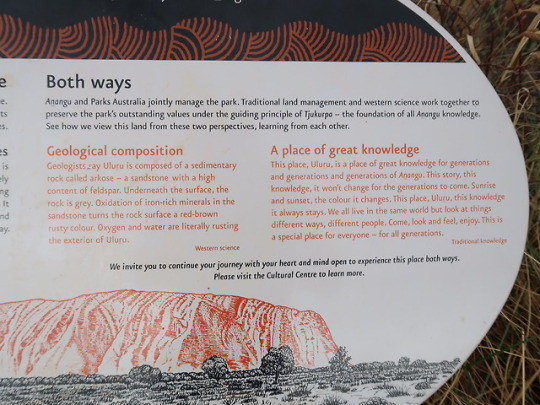

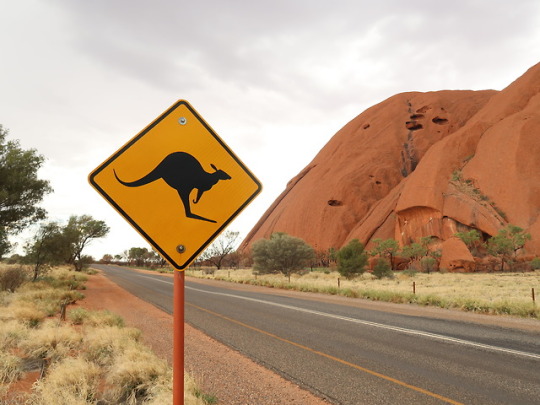
Uluru In The Rain
The parks department and the traditional owners of this land are careful to point out that there are two possible explanations for how Uluru (Ayers Rock) got here.
The geologists say that Uluru is the small tip of a six kilometer thick layer of very hard sandstone made from eroded granite that was laid down over hundreds of millions of years in a shallow sea and then distorted and eroded and twisted again over a few more hundred million years.
The indigenous Anangu people, for whom this site is sacred, believe that the sand python laid her eggs a few kilometers from there at Kata-Tjuta and then came over to Uluru to build a safe place and go to ground and left her shape and mark on the landscape.
I like both stories. You decide. Millions of years are hard to imagine.
I arrived here this afternoon and took off to drive around the rock a couple of times in each direction. As the day wore on, a few different storms passed through and you can see the little rivers of water cascading off the south side.
Then the rain started again and made a wonderful double rainbow visible in the evening from the sunset viewing area.
An amazing afternoon.
0 notes
Photo




Bury My Heart at Butchers Creek
In almost a month of traveling in Australia, it has been almost impossible to have a conversation with, or even a conversation about, indigenous aboriginal Australians. Those we have met are not interested in tourist chit chat and everyone else doesn’t know how to discuss the subject.
When I ask today’s Australians about the original Australians I get a range of responses. First there is the self avowed racist “They are only a percent of the population and what can we do anyway? What would this country have been if we hadn’t shown up, want us to stay in the stone age? And it’s stupid that someone who is only part aboriginal can claim all their rights” (see footnote)
Then we have the wholly patronising “We can’t just give them money as they’ll just spend it on booze and gambling”. Leave aside the fact that every pub in Australia has a betting shop and a room full of poker machines called pokies for booze and gambling of all sorts.
Finally we get the more realistic fatalist shrug that still leads nowhere … “Not sure we know what to do frankly. It’s a problem”.
Riding around Victoria this past week, it strikes me that one thing might be to actually recognize the events of the past and memorialize them.
The US 7th Cavalry massacred 300 Lakota indians at Wounded Knee. This is now a Historical National Landmark and the US Congress officially apologized in 1990 on the centenary of the event. In Victoria alone there were dozens of Wounded Knees in the mid 1800s. We have passed through a number of these places and I looked for any historical markers but didn’t find any.
When you read the Gippsland lifestyle magazine it is full of arty towns and horse riding advice and wine festivals but Victoria was also the epicentre of the clash between white squatters and the indigenous people. So much so that there is a wikipedia page dedicated to the Gippsland Massacres but there were atrocities all over the state - none of which are memorialized anywhere. It is hard to find ANY information actually; the closest is a document from the 1990s that was compiled for the Koorie Heritage Trust twenty years ago - shown here.
A classic example is in Benalla whose Wikipedia entry mentions the Faithful Massacre in which a handful of settlers died in an argument with the indigenous people but fails to mention the hundred or so locals who were slaughtered in reprisal by Angus McMillan. When you visit Benalla on the Broken River where these events took place next to the town historical museum, there is a plaque commemorating … you guessed it … Ned Kelly.
Yes, Australia has made huge strides to recognize traditional owners of the land and that was then and this is now. But just because nobody wants to remember, you can be sure that these stories are now woven into the oral histories and collective memories of the original Australians.
Footnote - This person was half right - Indigenous Australians are 3.4% of the population and in Victoria you can claim aboriginal status if you have 1/32nd original blood.
0 notes
Photo



English Corner - That’s All of Australia
A ride around Victoria is visually like a ride around England but without the ugly parts.
Everywhere resembles somewhere and everything is named for somewhere in the old country. We have visited Sale, Quorn, Stratford, Richmond, Anglesea, Torquay, Peterborough (more than one), Kingston … the list goes on.
Some of these places really do look like their namesakes; riding to Macclesfield through the Adelaide Hills you could imagine a drive across the Peak District into Cheshire with grazing sheep, sparse trees, and a few rocky windswept outcroppings. You have to ignore the odd kangaroo for this illusion to work of course.
Mansfield was actually named for Mansfield, Nottinghamshire but bears no resemblance to the one I know. The one here is in the foothills of the Victorian Alps, was founded on gold discoveries, and is now the gateway to the ski resort at Mount Buller. Like almost every town we have discovered in Australia it’s fresh, clean, friendly, and energetic - not so the other one.
0 notes
Photo
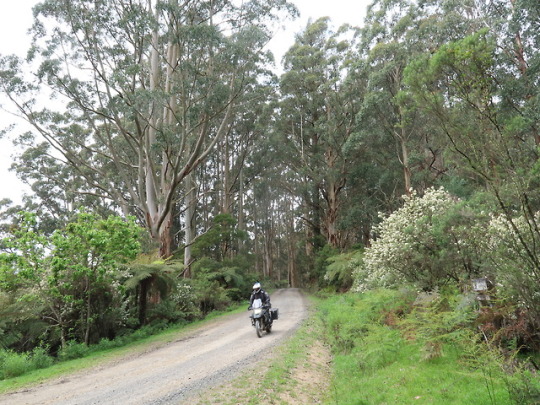
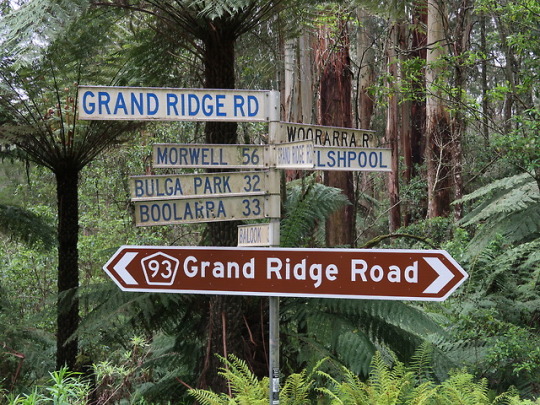
Grand Ridge Ride
The Grand Ridge Road (when Australians say “road” it does sound like “ride”) is 132km of motorcycle delight that runs along the ridge of the Strzelecki Ranges with occasional glimpses of the Bass Strait between here and Tasmania. This is the most southerly point in our little adventure.
The route is a logging road between stands of pine and massive old eucalyptus. Plantation and rain forest interspersed. A spectacular ride apart from the constant threat of logging trucks whose drivers do not seem to care if they hit anything.
This was our last real backroad dirt section on this trip - from here we are winding down and winding back to Melbourne.
0 notes
Photo

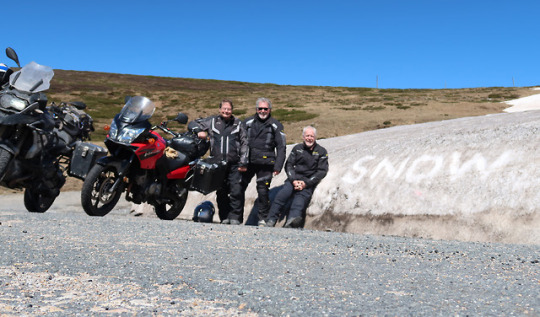

Ghosts of Fires Past
Riding on the Great Alpine Road in Victoria’s High Country is an eerily beautiful experience. Leaving Bright and heading south over Mount Hotham, you climb to around 6,000 feet very quickly and pass through clearly distinct layers from grassy valleys with grazing cattle to steeply wooded hills to an alpine tortured landscape - and ski lifts. Along the way the Snow Gum trees (Eucalyptus pauciflora) change from massive tall specimens to stunted bushes that are twisted and gnarled as they struggle to survive the loads of ice and snow that covers them in winter. Hard to imagine these are the same tree they look so different.
One thing they have in common ... how they burn.
This area has had severe bush fires in 2003, 2006 and 2013 that consumed the leaves and boiled the sap out of the thin barked tree leaving millions and millions of grey, bleached skeletons as far as the eye can see. Strangely beautiful.
The battle here, as in other parts of the world, rages between forest experts and farmers. The cattle were removed from these forests years ago to prevent damage to trails and water courses but the cattlemen claim that their animals can help trample and eat the fuel load in the forest.
0 notes
Text

Don’t be THAT guy,
Don’t be the guy that leaves the wireless remote key to his BMW on the back of the bike instead of in his pocket, The guy who then rides off so the key falls off in the street. The guy that luckily made it back to the bike rental place before the bike became immobilized forever because the key fob is a couple of miles away being crushed by traffic on one of Melbourne’s busiest roads.
Don’t be THAT guy. That guy is me.
That’s why I am riding a cherry red V-Strom POS (Piece of Suzuki) instead of the black BMW R1200GS on which I started this adventure.
I am actually thrilled that this happened just when we were back in Melbourne doing some repairs. If I had pulled this stunt in Broken Hill, that would have been the end of the trip. As it was, Trevor at Ride Australia Motorbike Rentals, took off on his own bike to try and find the key and then managed to find me another bike for the rest of the trip. This guy is a miracle worker.
I, on the other hand, am a complete idiot.
As we made our way south today from Bright to Orbost, we met a swarm of riders heading north after the MotoGP at Phillip Island. When I parked with these guys, NONE of them talked to the V-Strom rider. Not even the Kawasaki Ninja guys.
As Ned Kelly said “Ah Well. It’s Come to This. Such is Life”.
0 notes
Photo
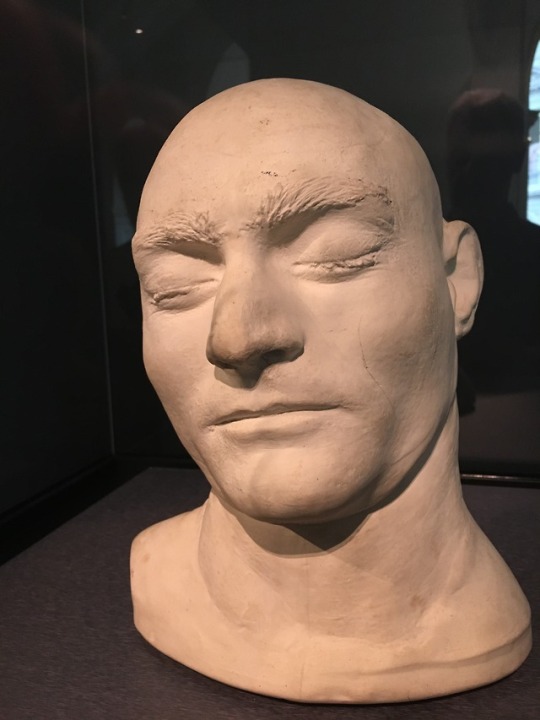
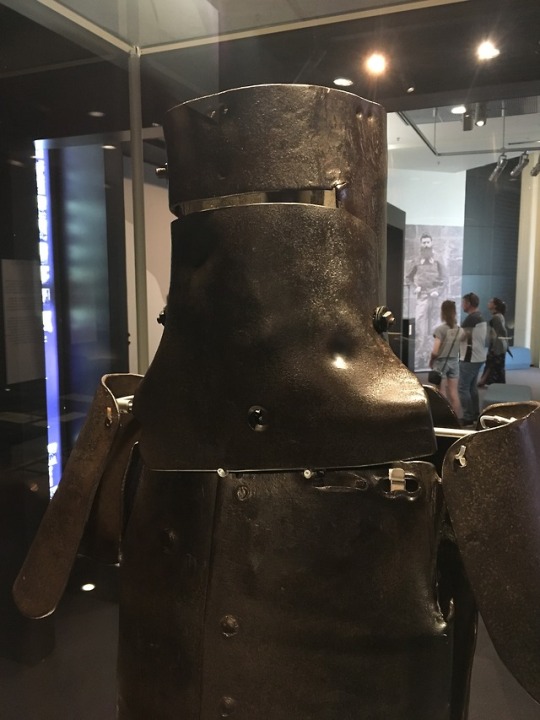
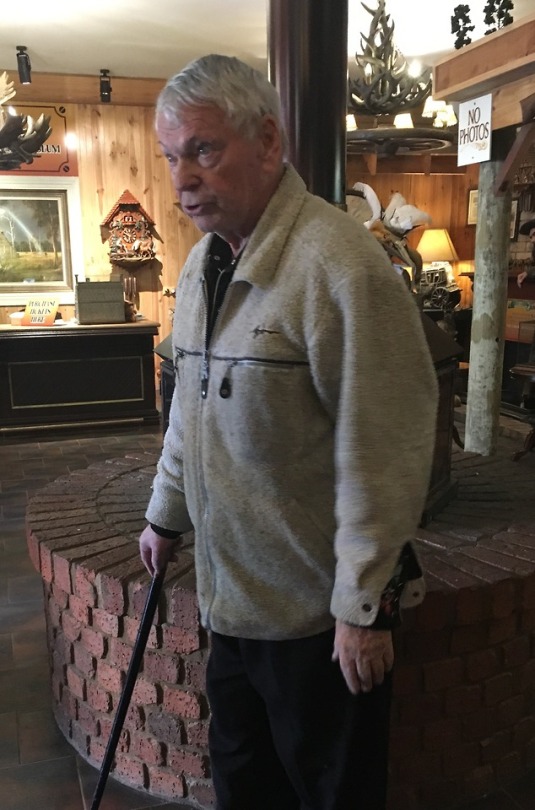

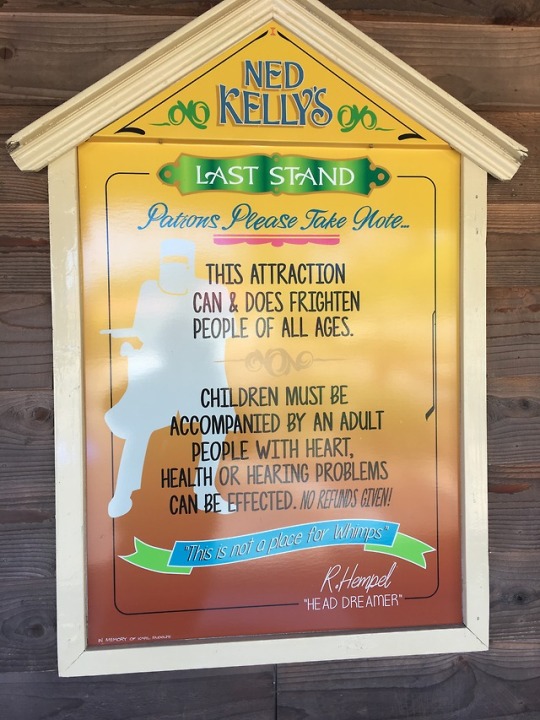
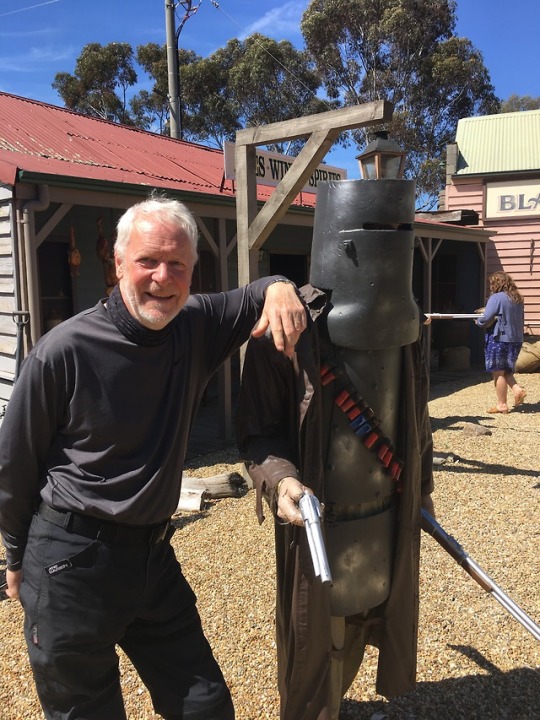
Ned Kelly - Such Is Life.
Ned Kelly is Australia’s only folk hero. Was he a rebel fighting for those downtrodden by the earlier squatters or simply a thief and murderer with a good marketing plan? Well he could have been both and he is certainly remembered for his last stand in 1880 at which he and his gang came out fighting dressed in homemade armour from head to toe. The gang all died, Kelly was injured and captured, and sentenced, and hung in Melbourne Gaol.
His last words were “Ah well. It’s come to this. Such is life”. He was 25.
These final events took place in Glenrowan, Victoria where we rode today through the beautiful King Valley countryside from Mansfield. We enjoyed a view of the events at Ned Kelly’s Last Stand, a museum show of complete over-the-top animatronic mayhem built by Bob Hempel in 1980 and developed and improved every year since.
I can see why the whole shebang gets mixed reviews but I loved it for the unapologetic, over enthusiastic kitsch.
We also had the unabashed delight of meeting and chatting to Bob before and after the show. He is now in his 80s and still lives with his grandson in rooms mixed with the Ned Kelly show. He is clearly still completely engaged in his creation even after 40 years and he is a natural storyteller. He had a big dream and he still pursues it probably without a care for what people think. He told us about his grandson “making the whole show better because he understands all that computer stuff” and regaled us with the tale of the visit by George Lucas who, I can totally believe, loved the show.
Corny but sincere and totally committed to Ned Kelly’s defense.
Photos - Post execution death mask taken from Kelly and the original armour - both almost hidden in the State Library of Victoria I visited a few weeks ago. Bob Hempel the creator of Ned Kelly’s Last Stand. Warning to customers and an example of the dioramas within. Me and Ned shooting it out with the police.
0 notes
Photo
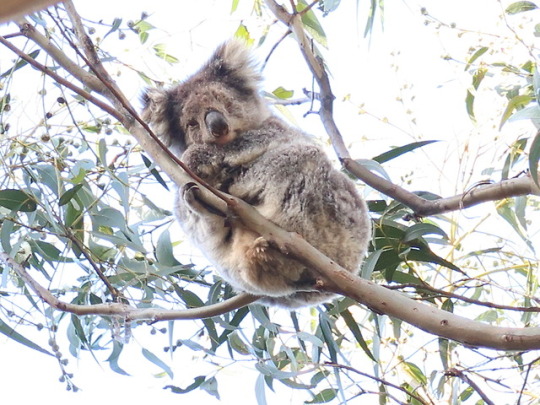

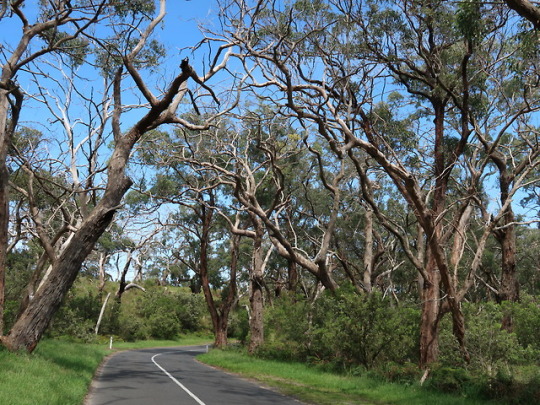
The Great Ocean Koala
Today we tackled the Great Ocean Road from Port Campbell to Geelong - 200 Km of spectacularness and fun on two wheels. We also threw in a dirt road loop up through the Otway National Park to Gellibrand - extra credit and extra fun through unlogged temperate rain forest. Hard to photograph the road and you don’t want to see the grins.
Three things stand out.
First the road itself is a pure delight. We hit some roadworks and a couple of slow vehicles but basically we had the road to ourselves for hundreds of curves of sheer grin-inducingness between the neat, charming, friendly seaside towns along the way.
Second, the cliff formations on the west end of the route are truly stunning. Here is an image of the 12 Apostles.
Finally, this is one of the places that you can predictably see koalas in the wild. They sleep 18 hours a day and this guy was in a post eucalyptus eating haze up a gum tree (literally) near Kennet River. Fun facts - koalas are not bears but marsupials (babies in pouches) - “koala” is from an aboriginal term for “no drink” because they, well, don’t drink - 80% of koala habitat has been lost and the rest is under threat. We saw a number of koalas on the road to Otway Lighthouse but 400 of them had been relocated to Kennet River because they had eaten themselves out of their preferred leaves, killing the tress in the process.
0 notes
Photo
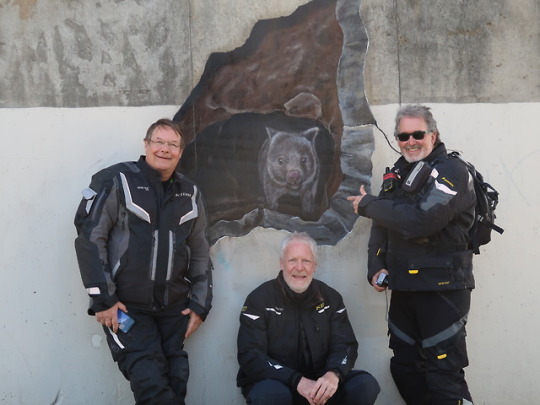

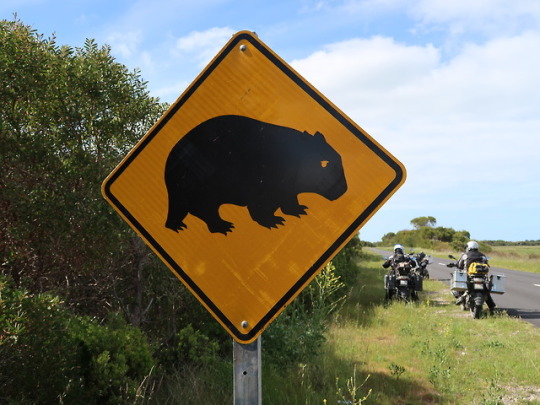


The Wombat of Warrnambool
Backstory if you haven’t seen the delightful video. Artist decides to draw a wombat in pastel on the railway bridge by his house. Local graffiti removal guy thought it was so lovely that he sprayed it with a few coats of clearcoat to preserve it forever. Artist returns to clean off his chalk. A friendship is born with the (now) graffiti preservation officer.
Watch the video here … https://www.youtube.com/watch?v=jmccJgw66vA
Anyway - we were going past here anyway so I tracked down the art and here we are. The photo was taken by the artist’s next door neighbor, Claire, who came out to chat and we met a couple walking their dog who were also delighted with the attention. Everyone’s a winner.
We, alas, did not see the artist or his new buddy - nor did we spot a wombat on the road. We are still looking.
0 notes
Photo
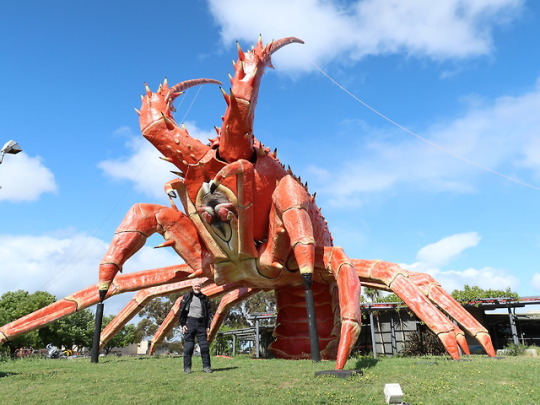


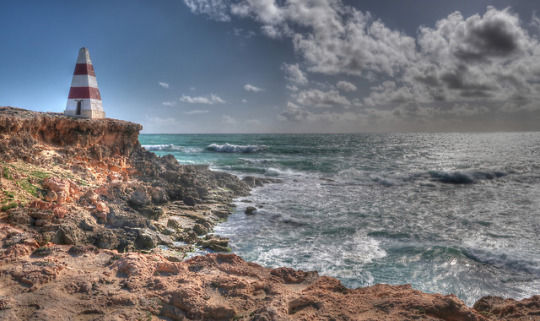
Roadside Kitsch - Finally
We have now ridden over 3000 miles in three states in Australia and never once seen a stupid corny “roadside attraction” … until today.
If we had driven 3000 miles around America, I can guarantee we would have seen a statue of Paul Bunyan with an axe, or a man made of mufflers, or a huge exterminator guy with a top hat and a hammer, or the world’s largest ketchup bottle, or a motel made of wigwams, or foamhenge (yes this exists) … well you get my point. There are hundreds of kitsch attractions that try to get you to pull over and buy something - and maybe try to prove that bad taste can be high art.
No so in Australia until we got to Kingston on the South Australia coast where there is a 50 foot lobster and “convention centre” … which is currently for sale to some enterprising new business owner.
The day was made even more bizarre by the discovery of a herd of grazing camels on the way tp Robe which is a delightful little sailing port with the bluest water I have ever seen.
Let’s call this day a strange version of “surf and turf”.
0 notes
Photo




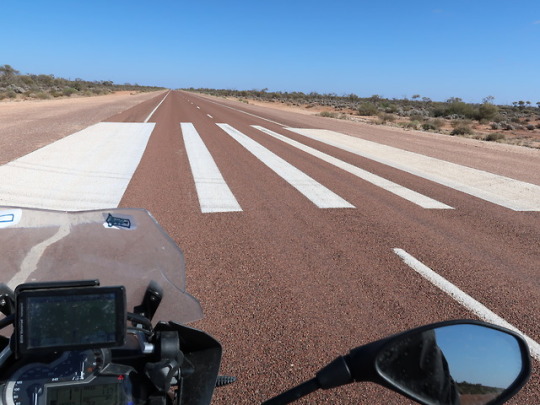
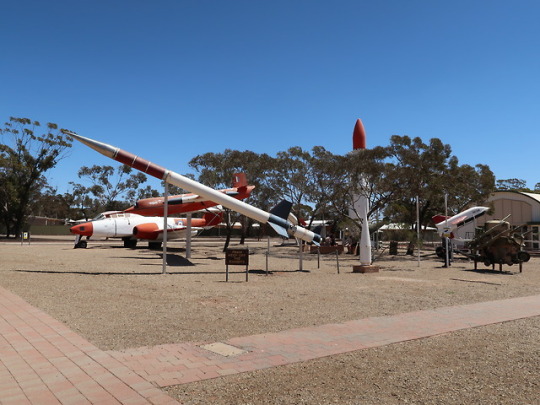
Rocket Men in Woomera
Woomera is the location of the Royal Australian Air Force (RAAF) base that supervises the missile test range that was setup jointly with the RAF after the Second World War. Initially it was over 100,000 square miles - the area of New Zealand or Colorado - but now it’s half that and still the biggest in the world.
The ride on the Stuart Highway to get here from Coober Pedy and onwards to Port Augusta is mind numbingly boring - 650Km of nothing at all except the odd errant emu to keep you awake. A chunk of the highway is also marked as a landing strip for the Royal Flying Doctor Service.
If you wanted to put a missile testing facility in a place where nothing could get damaged, then here it is in the sterile centre of Australia. Indigenous Australians would and did take issue with this assumption but their voices were not heard in the 1940s.
In the town that is now publicly accessible there are two blocks of old missiles on stands with very rudimentary little plaques. All rusting, peeling, and fading in the fierce sun - signs of a more glorious past for the aerospace industries of two countries now both eclipsed by larger military industrial complexes. Weapons like Blue Steel that was a precursor to cruise missiles and the incomprehensibly named Sea Slug.
Not shown in the local displays is the fact that Woomera was also the site of an immigration processing centre built in 1999. A sign of a different political development and a desire to keep refugees along way from public view. It didn’t work. The centre had capacity for 400 people but grew to 1500 and led to riots inside the camp and massive protests outside. It was closed in 2003 and most of the people there given temporary status whilst their asylum claims were being processed. It was actually run by a US private prison company showing the reach of this particular pernicious recent development.
0 notes
Photo
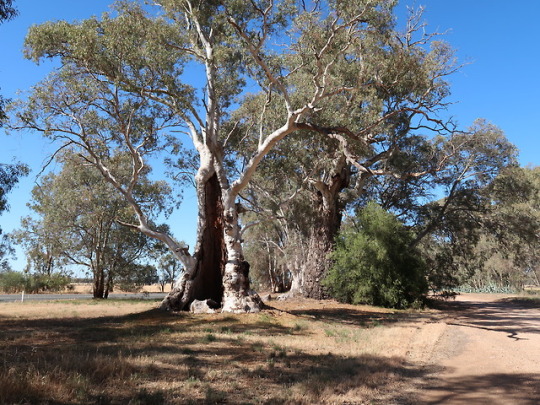

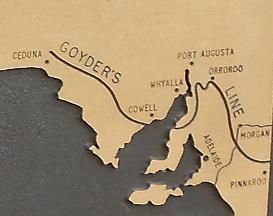
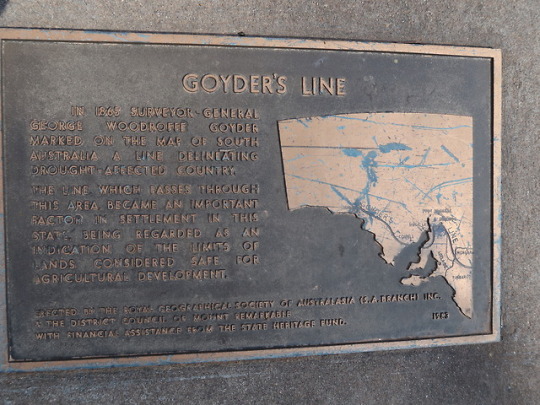


From Quorn to Adelaide - A Ride Through Science and Time
In 1865, George Goyder the Surveyor-General of South Australia rode over 3000 Km to develop a map that would help farmers decide where they could plant crops. He drew a line across the colony that roughly corresponded to 10 inches of rain per year and declared land to the north “liable to drought” and to the south safe for arable farms. Some farmers ignored his map and planted to the north as they believed in the popular doctrine from the US West that “rain follows the plough” but this fallacy led to them abandoning their farms
Today, a century and a half later, this delineation is still very much obvious and a testament to a wonderful piece of science given the resources at the time.
We left Quorn and rode through dry, lifeless scrub with no grass and very little other vegetation but within 30 Km we started to see gum trees with their mangled and gnarled trunks in the creek beds where there is occasional water. By the time we had gone 50 Km, we were in rolling grass and farmland and after that perfectly curated wine country.
There is a small marker to honour Goyder near Mount Remarkable in Melrose and, looking at the latest Google Maps satellite picture, it is clear that the line has moved south as the climate has warmed and dried. Something Goyder could not have foreseen.
This route is such a pleasant jaunt. It takes you through an Australian time warp - like someone set the dial back to 1965. The townships were all perfectly preserved from another epoch and we did not see a single “big box” store in any of the towns. The general store in Georgetown was not a museum piece; just still the hub of the town with everything that anybody needs that nobody has updated for decades. I asked the shopkeeper serving Bill about business and he said “Well I can still eat”.
We didn’t let Michael into the Wilmington Toy Store as he was salivating.
0 notes
Photo
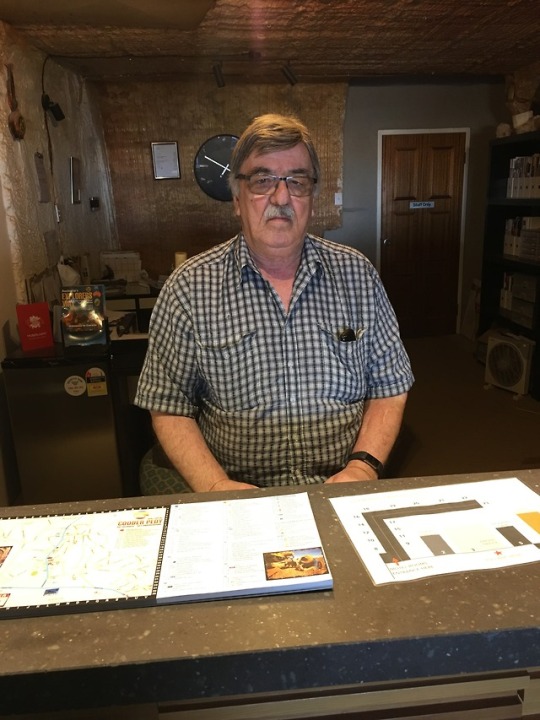

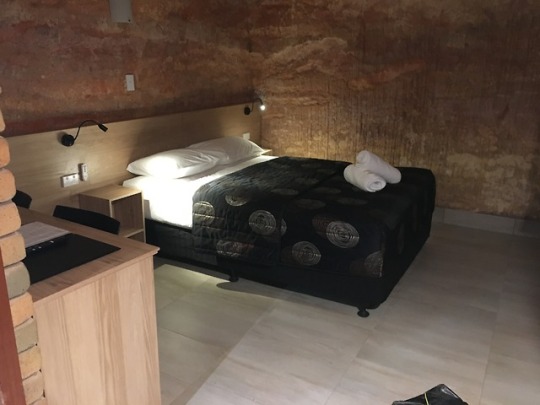

From Greece to Coober Pedy
Coober Pedy is the largest opal mining area in the world and provides most of the world’s gem quality opals. The town is clearly past its peak, however, and most of the town’s businesses seem to cater to tourists looking for boomerangs and didgeridoos rather than opals.
Most of the residents live underground in houses that have been made from old mine shafts and many of the hotels are made this way too including the Lookout Cave where we stayed. An underground hotel with a sunset view over the town - an amazing combination.
The hotel is owned by a Greek family and I chatted to the patriarch, Nick. His father moved here in 1959 and Nick followed the year after at age 16 with the rest of his family. He remembers when they came it cost them 250 Pounds but those coming from Britain could get a ticket for 10 Pounds - these migrants are still called the “Ten Pound Poms”.
He worked with two brothers who were pushing a mine into the side of the hill “with axes and dynamite” and who were living in the mined dugouts until the late 1980s. When the mine didn’t work out, they rented the first two dugouts and kept digging more. Later Nick encouraged his daughters to buy the property and they opened the hotel in 1993.
On the hilltop above a very unremarkable frontage, you can see the vents to all the rooms and the original oil drums that lined the first vent to the mine. But when you step into the hallway and rooms, you get a real shock as you enter an entirely different world. Outside is dust and heat and dry wind but inside is a superbly appointed and perfectly laid out luxury hotel.
The interior is always 22-25 degC year round - whether it’s 50 degC or 5 degC outside. A gem in a hillside where no gems were found.
0 notes